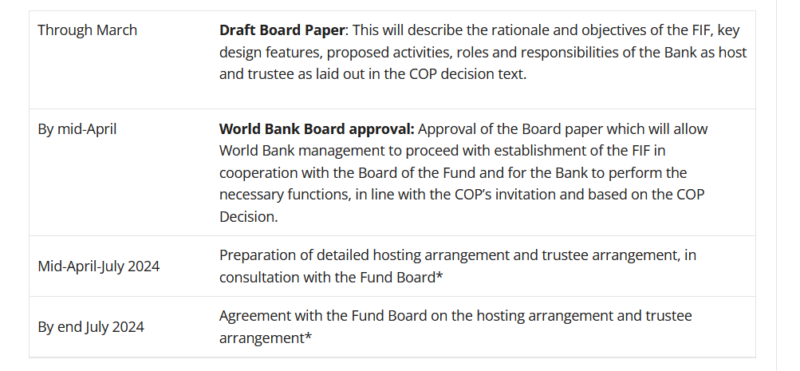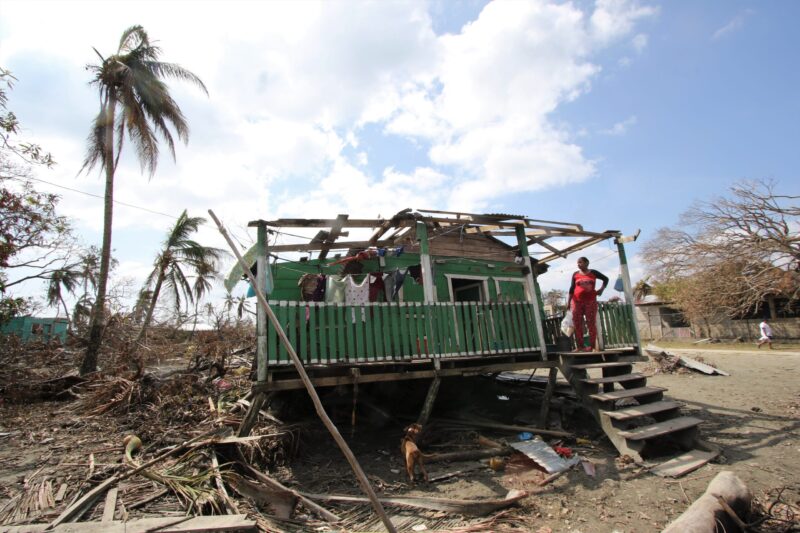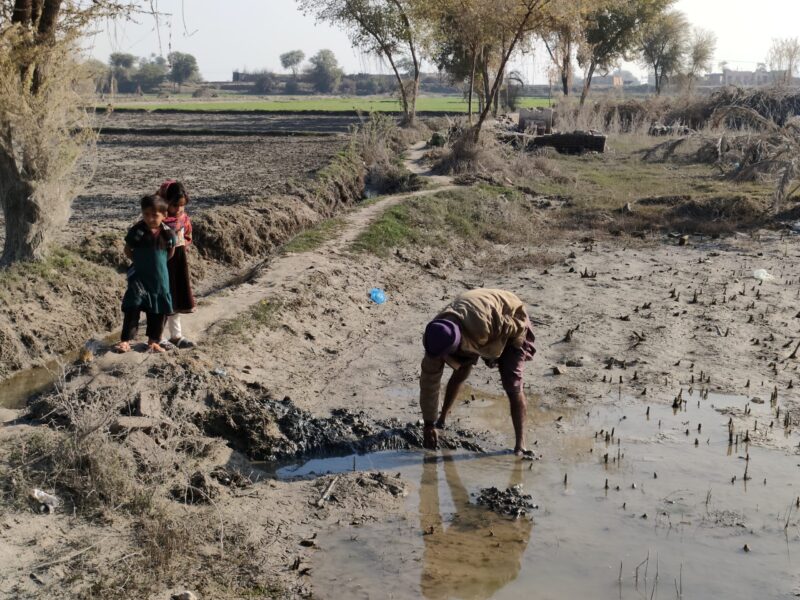The newly appointed board of the climate finance world’s latest entry – the hard-won UN “loss and damage” fund – will likely hold its first meeting in late April after delays in agreeing members. But despite soaring needs for help, the fund itself isn’t expected to hand out any money until 2025 at the earliest, officials say.
The World Bank – the fund’s expected host – said on its website last week that its own board anticipates approving a formal plan to become the fund’s “financial intermediary” by mid-April, with a final operating deal due to be in place with the fund by the end of July.
But would-be recipients of the loss and damage fund’s resources are already jostling for position in a growing queue of nations hoping for help – and its board faces an unenviable task: figuring out how to fairly divide very little money among too many people in desperate need of it, as climate impacts accelerate in a warming world.

Timetable of steps the World Bank plans to undertake to become host of the new UN loss and damage fund (Source: World Bank)
Pakistan, for instance, is still seeking about $16 billion to rebuild roads, bridges, schools and more, after 2022 floods inundated a third of the country. In southern Africa, Zambia – hit by a severe drought that has ruined half of this season’s staple maize crop – wants support to shore up its dwindling water supplies.
Vulnerable countries – from Pacific and Caribbean island nations to Bangladesh – are looking for money to cover growing losses as warmer seas drive stronger hurricanes and cyclones. And in Senegal, where higher oceans are accelerating coastal erosion, families watching their ancestors’ skeletons float out to sea from flooded graveyards are asking for cash to rebuild crumbling coastal communities.
“The need is for trillions (of dollars) – and what we have is millions, not even billions,” said Ritu Bharadwaj, a climate finance and governance researcher at the UK-based International Institute for Environment and Development who has closely followed the new fund’s evolution. So far, it has garnered about $700 million in pledges.
With the residual costs from loss and damage projected to reach a total of $290 billion to $580 billion by 2030, according to a 2018 study, the loss and damage fund aims to ramp up its resources significantly, largely by persuading donor governments it can use their money effectively.
In partnership with a new taskforce on international taxation, it is also exploring how to harness innovative but politically tricky funding sources such as levies on fossil fuels, aviation, shipping and financial transactions.
UN’s climate body faces “severe financial challenges” which put work at risk
To make limited resources stretch further, fund observers like Bharadwaj have urged the board to consider ways to reach vulnerable people directly, such as cash transfers when a pre-set trigger point is passed – for example, a top-strength hurricane hitting an at-risk zone.
That approach would cut out middleman delivery agencies that critics say now claim too much of climate finance flows and reduce the amounts getting to the frontlines.
Bharadwaj and some others also believe the fund should consider supporting so-far inadequate efforts to build resilience to worsening climate shocks, rather than just responding once they happen – in order to curb future demands for assistance.
That could include helping Zambia’s farmers build community irrigation systems to avoid them coming back to the fund repeatedly to cover crop losses from warming-fuelled drought.
“We need to be more responsive to the comprehensive risks the communities are facing,” said Bharadwaj.
Between relief and resilience
However, Avinash Persaud, a loss and damage fund board member from Barbados representing Latin American and Caribbean nations, said the fund should focus on its core mission – helping the worst-hit communities and countries recover and rebuild after climate impacts – rather than responding to well-intentioned pleas to expand its work.
“This fund is not replacing relief agencies. This is not a resilience-building fund,” he told Climate Home. “This is doing the stuff in the middle – what happens the day after the relief agencies pack up and leave your people fed and watered but under blue tarpaulins.”
The fund could support the reconstruction of devastated towns in a safer location, repairs to roads, bridges and schools – or anything else that “reboots the community”, said Persaud, an economist noted for helping design the Bridgetown Initiative, which aims to reshape international finance flows to help debt-strapped countries boost climate protection.

Damage in a Miskito indigenous community called Wawa Bar, after being the epicenter of Hurricane Eta, on the Caribbean side of Nicaragua. The North Caribbean, one of the poorest regions of Nicaragua, was plunged into uncertainty and despair after the double blow of hurricanes Eta and Iota, which sowed death and destruction in Central America, Puerto Cabezas, Nicaragua, November 23, 2020 (Photo: Katlyn Holland/CRS / Latin America News Agency via Reuters)
With the loss and damage fund’s 26-strong board now in place – albeit several weeks late and yet to name one developing-world member with only an alternate from India listed for that seat – it is expected to start work in April to establish its operating rules.
The board is set to grapple with a range of contentious discussions, including whether a share of support should be given as concessional loans rather than simple grants.
Also up in the air is whether money should move straight to governments and local organisations or also through international partners – including development banks and UN agencies – and how much direct access to the fund vulnerable communities should have.
African dismay at decision to host loss and damage advice hub in Geneva
With the UN-backed Green Climate Fund, for example, about three-quarters of funding has been channeled to countries via international organisations and only a quarter has been delivered directly to developing countries and regions for projects.
Harjeet Singh, who has tracked efforts to establish the fund for more than a decade and is now global engagement director at the Fossil Fuel Non-Proliferation Treaty Initiative, said he was hopeful “this fund is going to be different from the ones we’ve had so far”.
Fund with ‘a clean slate’
Michai Robertson, a senior advisor for the Alliance of Small Island States and a research fellow at the UK-based global affairs think-tank ODI, said language in the agreement setting up the fund should help ensure it operates in new ways.
In making allocations, for instance, the board – which aims to disburse money far faster than existing climate funds – will have to balance the needs of countries that have sustained large climate losses with setting aside a basic floor of support for poorer or highly vulnerable nations where the overall bill is smaller but some communities are hit very hard.
Currently, small island developing states get just 2% of international climate finance and least-developed countries, largely in Africa, about 8-10%, Robertson noted.
“You don’t want one country to take up all the scarce resources,” he said.
In Somalia, Green Climate Fund tests new approach for left-out communities
The fund’s agreement also says that vulnerable countries and communities should have a large say in deciding priorities for using its money – and that Indigenous and other community knowledge of local risks should be considered as a valuable source of information, especially when climate risk modelling is lacking in some countries.
The fund will also address some “non-economic” losses and damage – such as the disappearance of nature a community relies on, or cultural institutions – in the form of finance to help rebuild a ruined museum or replant lost mangroves, Singh said.
Bharadwaj said she hoped the fund can act in a way that is catalytic, helping countries fill the gaps in other funding streams – from climate adaptation and resilience, to development and humanitarian aid.
“When an existing institution or organisation does things in a certain way, it takes a lot of effort to change that. But the loss and damage fund is not carrying any baggage behind it. Here we have a chance for a clean slate,” she said.
